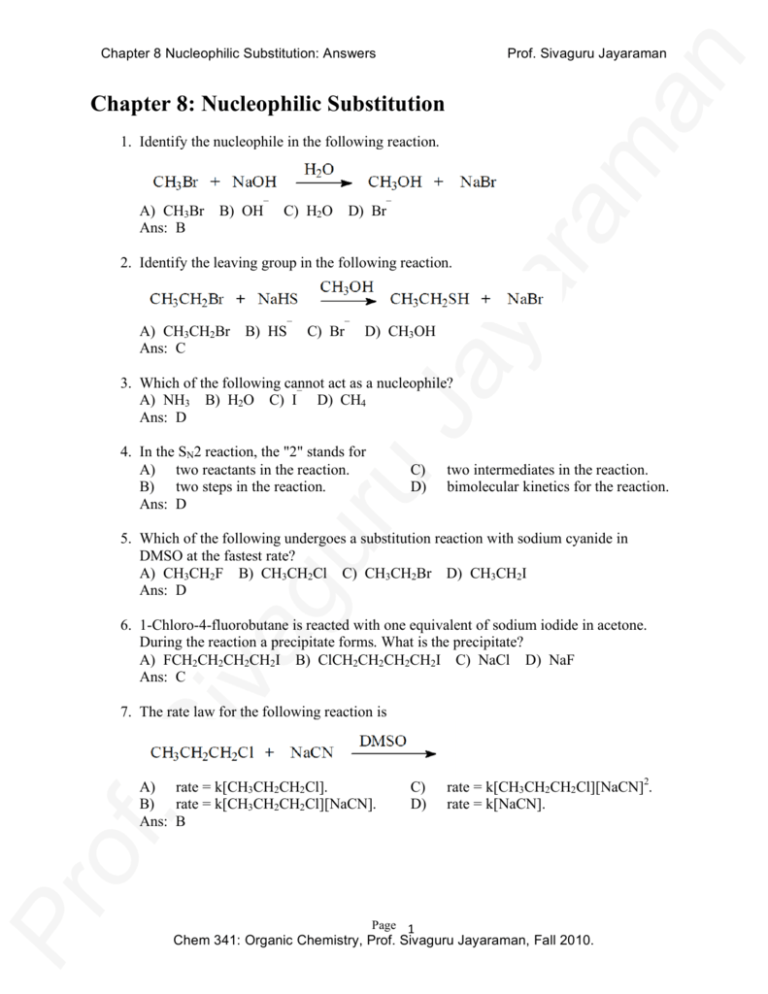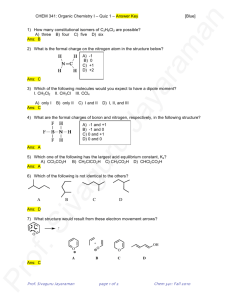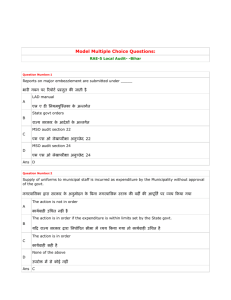Chapter 8: Nucleophilic Substitution
advertisement

Chapter 8 Nucleophilic Substitution: Answers Prof. Sivaguru Jayaraman Chapter 8: Nucleophilic Substitution 1. Identify the nucleophile in the following reaction. A) CH3Br Ans: B B) OH¯ C) H2O D) Br¯ 2. Identify the leaving group in the following reaction. A) CH3CH2Br Ans: C B) HS¯ C) Br¯ D) CH3OH 3. Which of the following cannot act as a nucleophile? A) NH3 B) H2O C) I¯ D) CH4 Ans: D 4. In the SN2 reaction, the "2" stands for A) two reactants in the reaction. B) two steps in the reaction. Ans: D C) D) two intermediates in the reaction. bimolecular kinetics for the reaction. 5. Which of the following undergoes a substitution reaction with sodium cyanide in DMSO at the fastest rate? A) CH3CH2F B) CH3CH2Cl C) CH3CH2Br D) CH3CH2I Ans: D 6. 1-Chloro-4-fluorobutane is reacted with one equivalent of sodium iodide in acetone. During the reaction a precipitate forms. What is the precipitate? A) FCH2CH2CH2CH2I B) ClCH2CH2CH2CH2I C) NaCl D) NaF Ans: C 7. The rate law for the following reaction is A) rate = k[CH3CH2CH2Cl]. B) rate = k[CH3CH2CH2Cl][NaCN]. Ans: B C) D) rate = k[CH3CH2CH2Cl][NaCN]2. rate = k[NaCN]. Page 1 Chem 341: Organic Chemistry, Prof. Sivaguru Jayaraman, Fall 2010. Chapter 8 Nucleophilic Substitution: Answers Prof. Sivaguru Jayaraman 8. Which of the following reacts the fastest by the SN2 mechanism? A) CH3Br B) CH3CH2Br C) (CH3)2CHBr D) (CH3)3CBr Ans: A 9. Give the product(s) of the following reaction? A) A B) B C) C D) a mixture of A and B Ans: B 10. Which halide ion reacts the fastest with cyclopentyl p-toluenesulfonate in ethanol/water? A) A B) B C) C D) D Ans: A Page 2 Chem 341: Organic Chemistry, Prof. Sivaguru Jayaraman, Fall 2010. Chapter 8 Nucleophilic Substitution: Answers Prof. Sivaguru Jayaraman 11. Which one of the following species forms the strongest ion-dipole attraction with 18crown-6? A) F- B) K+ Ans: B C) Cr2O72- D) Br2 12. Identify the major product(s) in the reaction of (R)-2-bromopentane with sodium cyanide in DMSO? A) (R)-2-cyanopentane C) racemic mixture of 2-cyanopentane B) (S)-2-cyanopentane D) trans-2-pentene Ans: B 13. Which of the following reacts fastest with methanol by the SN1 mechanism? A) A B) B C) C D) D Ans: C 14. A pentacoordinate carbon is a transition state in the _____ mechanism. A) SN1 B) SN2 C) E1 D) E2 Ans: B Page 3 Chem 341: Organic Chemistry, Prof. Sivaguru Jayaraman, Fall 2010. Chapter 8 Nucleophilic Substitution: Answers Prof. Sivaguru Jayaraman 15. What is the leaving group in the following reaction? A) OHAns: B B) H2O C) CH3CH2+ D) C1- 16. Considering the SN1, SN2, E1, and E2 mechanisms, the energy diagram shown below corresponds to A) only the SN1 mechanism. B) only the SN2 mechanism. Ans: D C) D) both the SN1 and E1 mechanisms. both the SN2 and E2 mechanisms. 17. Which of the following is the rate law for the SN1 mechanism of an alkyl halide with a nucleophile? A) rate = k[alkyl halide] C) rate = k[alkyl halide][nucleophile] B) rate = k[nucleophile] D) rate = k[alkyl halide]2[nucleophile] Ans: A 18. Which of the following bases works best to maximize the E2 product in the reaction shown below? A) KOCH2CH3 Ans: C B) NaOCH2CH3 C) NaOC(CH3)3 D) NaOH 19. Which of the following does not correctly describe SN2 reactions of alkyl halides? A) Tertiary halides react faster than secondary halides. B) Rate of reaction depends on the concentrations of both the alkyl halide and the nucleophile. C) The mechanism consists of a single step with no intermediates. D) The transition state species has a pentavalent carbon atom. Ans: A Page 4 Chem 341: Organic Chemistry, Prof. Sivaguru Jayaraman, Fall 2010. Chapter 8 Nucleophilic Substitution: Answers Prof. Sivaguru Jayaraman 20. Identify the substitution product(s) in the following reaction. A) A B) B C) C D) a mixture of A and B Ans: D Page 5 Chem 341: Organic Chemistry, Prof. Sivaguru Jayaraman, Fall 2010. Chapter 8 Nucleophilic Substitution: Answers Prof. Sivaguru Jayaraman 21. What is the major product of the following reaction? A) A B) B C) C D) D Ans: C 22. Starting with 1-hexene, which synthetic sequence below gives 2-cyanohexane? A) (1) H2SO4 (cat.), H2O (2) NaCN B) (1) HBr/peroxide (2) NaCN C) (1) HBr (2) NaCN D) (1) Br2, H2O (2) NaCN Ans: C Page 6 Chem 341: Organic Chemistry, Prof. Sivaguru Jayaraman, Fall 2010. Chapter 8 Nucleophilic Substitution: Answers Prof. Sivaguru Jayaraman 23. Which sequence of reactions below gives the highest yield of ethyl isopropyl ether? A) A B) B C) C D) D Ans: B 24. In the solvolysis of t-butyl chloride, a minor product is 2-methylpropene, which results from the: A) B) C) D) Ans: E2 mechanism with OH¯ acting as the base. E2 mechanism with H2O acting as the base. E1 mechanism with OH¯ acting as the base. E1 mechanism with H2O acting as the base. D 25. What is the rate limiting step in the following reaction? A) A B) B C) C D) D Ans: A Page 7 Chem 341: Organic Chemistry, Prof. Sivaguru Jayaraman, Fall 2010. Chapter 8 Nucleophilic Substitution: Answers Prof. Sivaguru Jayaraman 26. The mechanism of the following reaction is A) SN1. Ans: B B) SN2. C) E1. D) E2. 27. Which of the following reacts the slowest with sodium cyanide, NaCN? A) A B) B C) C D) D Ans: B 28. How would you synthesize the following compound starting with optically pure (R) or (S)-2-butanol? A) B) C) D) Ans: (1) (R)-2-butanol + TsCl (1) (S)-2-butanol + TsCl (1) (S)-2-butanol + H2SO4 (heat) (R)-2-butanol + NaCN/DMSO A (2) NaCN/DMSO (2) NaCN/DMSO (2) HBr (3) NaCN/DMSO Page 8 Chem 341: Organic Chemistry, Prof. Sivaguru Jayaraman, Fall 2010. Chapter 8 Nucleophilic Substitution: Answers Prof. Sivaguru Jayaraman 29. Starting with optically pure (R) or (S)-2-butanol which method below would give the best yield of the following ether? A) B) C) D) Ans: (1) (R)-2-butanol + TsCl (2) CH3ONa (1) (S)-2-butanol + TsCl (2) CH3ONa (1) (R)-2-butanol + Na (2) CH3I (1) (S)-2-butanol + Na (2) CH3I D 30. Which of the following conditions favor the SN1 mechanism as opposed to the SN2 mechanism? I. tertiary alkyl halide II. primary alkyl halide III. polar solvent A) only I B) only II C) I and III D) II and III Ans: C 31. The species shown below represents the transition state for the A) B) C) D) Ans: reaction of 1-propanol with HBr. reaction of 1-bromopropane with OH–. elimination of HBr from 1-bromopropane. addition of HBr to propene with peroxides. B 32. The species shown below represents the transition state for the A) B) C) D) Ans: reaction of 1-propanol with HBr. reaction of 1-bromopropane with OH–. addition of HOBr to 1-propene. addition of HBr to propene with peroxides. A Page 9 Chem 341: Organic Chemistry, Prof. Sivaguru Jayaraman, Fall 2010. Chapter 8 Nucleophilic Substitution: Answers Prof. Sivaguru Jayaraman 33. Which of the following is the double substitution product of the reaction below? A) A B) B C) C D) D Ans: A Page 10 Chem 341: Organic Chemistry, Prof. Sivaguru Jayaraman, Fall 2010. Chapter 8 Nucleophilic Substitution: Answers Prof. Sivaguru Jayaraman 34. Starting with 1-methylcyclohexene, which of the following reaction sequences is the best synthesis of the azide shown below? A) A B) B C) C D) D Ans: C 35. Rank the following in decreasing order of leaving group ability. A) I > III > IV > II B) I > III > II > IV Ans: B C) D) III > II > I > IV II > I > III > IV 36. Identify the mechanistic pathways, respectively, for the products in the following reaction. A) E1, SN1 Ans: D B) E1, SN2 C) E2, SN1 D) E2, SN2 Page 11 Chem 341: Organic Chemistry, Prof. Sivaguru Jayaraman, Fall 2010. Chapter 8 Nucleophilic Substitution: Answers Prof. Sivaguru Jayaraman 37. Identify the mechanistic pathways, respectively, for the products in the following reaction. A) E1, SN1 Ans: A B) E1, SN2 C) E2, SN1 D) E2, SN2 38. What is the major product in the following reaction? A) A B) B C) C D) D Ans: D Page 12 Chem 341: Organic Chemistry, Prof. Sivaguru Jayaraman, Fall 2010. Chapter 8 Nucleophilic Substitution: Answers Prof. Sivaguru Jayaraman 39. Which of the following mechanistic steps is the most likely route for the formation of the cyclic ether shown? A) A B) B C) C D) D Ans: C 40. In which of the solvents below would the reaction shown take place at the fastest rate? A) ethanol Ans: C B) acetic acid C) dimethyl sulfoxide D) water 41. Consider the reaction of each of the following with 1-bromopentane. Which one would have the highest elimination/substitution ratio? A) NaOCH2CH3, ethanol, 55oC C) KOC(CH3)3, (CH3)3COH, 55oC o B) NaSH, ethanol-water, 25 C D) KCN, DMSO, 40oC Ans: C Page 13 Chem 341: Organic Chemistry, Prof. Sivaguru Jayaraman, Fall 2010. Chapter 8 Nucleophilic Substitution: Answers Prof. Sivaguru Jayaraman 42. Which one of the following correctly describes the reaction below? A) A B) B C) C D) D Ans: D 43. Which of the following undergoes SN1 solvolysis in ethanol/water at the fastest rate? A) A B) B C) C D) D Ans: A 44. The major product of the following reaction is an alcohol. Which of the following best describes this reaction? A) SN2 with inversion of configuration B) SN2 with racemization Ans: D C) D) SN1 with inversion of configuration SN1 with racemization Page 14 Chem 341: Organic Chemistry, Prof. Sivaguru Jayaraman, Fall 2010. Chapter 8 Nucleophilic Substitution: Answers Prof. Sivaguru Jayaraman 45. What reagent would you choose to get the best yield of this product? A) CH3ONa B) CH3CH2OK Ans: D C) (CH3)2CHONa D) (CH3)3COK 46. The major product(s) of this reaction would be CH3OH (R) only A) only (R) Ans: C H ? Br B) only (S) C) (R) and (S) D) achiral 47. The major product(s) of this reaction would be (R) only A) only (R) Ans: B CH3SNa H ? Br B) only (S) C) (R) and (S) D) achiral 48. The major product(s) of this reaction would be (R) only A) only (R) Ans: D CH3ONa H Br B) only (S) C) (R) and (S) ? D) achiral 49. Which mechanism is least important for reactions of alkyl halides and sulfonates? A) SN1 B) SN2 C) E1 D) E2 Ans: C Page 15 Chem 341: Organic Chemistry, Prof. Sivaguru Jayaraman, Fall 2010. Chapter 8 Nucleophilic Substitution: Answers Prof. Sivaguru Jayaraman 50. The major product expected from the reaction below would be CH3 Br NaCN ? CH3OH CH3 CH3 CH3 CH2 OCH3 CN A B A) A B) B C) C D) D Ans: C C D 51. What major product, if any, is expected here? I CH3 CH3OH ? cis + trans OCH3 OCH3 CH3 CH3 CH3 cis + trans A B A) A Ans: C C D: no reaction occurs B) B C) C D) D Page 16 Chem 341: Organic Chemistry, Prof. Sivaguru Jayaraman, Fall 2010.








